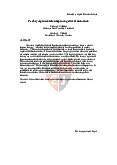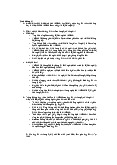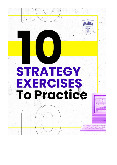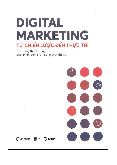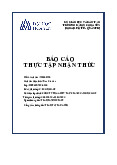

















Preview text:
COURSE OUTLINE Course ID Course tittle Credits MK302DE01 International Marketing 3
(To be applied to: ❍ Main Semester ❍ Extra Semester - …, School year: from …..)
A. Course Specifications Periods Periods in classroom Total Lecture/ Laboratory/ Self-study Lecture Lab periods Seminar Studio Activity Fieldwork periods room room Fieldwork (1) (2) (3) (4) (5) (6) (7) (8) (9) 45 39 0 0 6 90 39 0 6
(1) = (2) + (3) + (4) + (5) = (7) + (8) + (9) B. Other r elated Subjects Pre-requisites Principles of Marketing Co-requisites Not compulsory
Students those are used to study foundation subjects, such as:
micro – economics, macroeconomics, consumer behaviors, Other required
strategic management, integrated marketing communication
(IMC) and foreign trade are more beneficial in term of learning this subject. C. Course Description 1
This course explores the development of international marketing programs from the
determination of objectives and methods of organization through the execution of research,
advertising, distribution, and production activities. Students examine the international
similarities and differences in marketing functions as related to the cultural, economic,
political, social, and physical dimensions of the environment. Students also consider the
changes in marketing systems and the adoption of marketing philosophies and practices to fill
conditions in different countries. D. Course Objectives No. Course Objectives E.
Understanding the key terms, definitions, and concepts used in marketing with an 1 international perspective.
Evaluate different economic, social, cultural, political, and legal environments 2
influencing international trade.
Explain the impact of global and regional influences on products and services for 3
consumers and businesses through international marketing research.
Apply basic internationally oriented marketing strategies (total product concept, 4
pricing, place, and promotion). Learning Outcomes
A student has the ability to analyze, discuss, describe, and demonstrate the marketing
processes and strategies that firms utilize when marketing their products in a foreign countries. F. Instructional Modes
- Maximum for classroom/ laboratory instruction is 45 periods which consists of 39 for
theoretical lectures and 6 for a field trip, meaning that there is one lesson per week.
Instructor will deliver the lectures in English slides. Students read documents in English.
- Prior going to the class students must read related theories in advance.
- In class, instructors will emphasize important or difficult concepts and ideas.
- It is required pair works among students at the end of any lesson in order to comprehend
knowledge through case studies.
- If there is any problem, students are supposed to discuss with friends or instructor. 2 No. of No. Method Description Number of students periods
Lecturer will teach theoretical issues through classroom/ 1 Lecturers
laboratory lectures with power 45 30 students point, computers, projectors, videos or case studies. Each group from 5-6 students will be assigned a project Group according to specific assignments 2 requirements of lecturer. In 6 5-6 students/group and order to complete the presentation
assignment, it is asked to have presentation at class. G. T
extbook and teaching aids
1. Required Textbooks and Materials
Warren J. Keegan, Mark C. Green, Simpson College (2017), Global Marketing, 9th Edition, Pearson USA
2. Suggested Course Materials
- Hollensen, S., 2010. Global Marketing: A decision-oriented approach, 5th Edition, Prentice Hall.
- Levinson, Conrad Jay,. Levinson, Jannie (2011). Guerrilla Marketing Remix - The Best
of Guerrilla Marketing, Entrepreneur Press – U.S.A
- Friedman. Thomas L. (1999) The Lexus and the Olive Tree – Understanding
Globalization, Newly updated and expanded edition, Various Publishers.
- Friedman. Thomas L. (2007) The World Is Flat - The Globalized World in the Twenty-
First Century, Penguin Books
- Doodle, Lowe (2012) International Marketing Strategy, 6Th Edition, Cengage Learning EMEA 3. W ebsites
- www.cafef.vn, www.brandsvietnam.com, cnbc.com. H. Asses sment 3
1. Learning outcomes assessment No Assessment Percentage Requirements .
Lecturers can choose either quizzes, 1 In class assignment 40%:
group presentations, report, Q&A or multiple assignments.
Each student group must write a
report to either analyze or compare
one or multiple real international
marketing campaign(s). Specific and
real data, evidences or illustrations are strictly required. 2 Final group report 60%:
Each group is required to present their work in class.
Each group member’s contribution
evaluation by peers must be included in the final report.
* Note: Lecturer and students are allowed to organize the following activities:
Fieldtrip: : students are arranged to visit a foreign company operating business in
Vietnam or a Vietnamese company operating domestically but focusing on exporting. OR
Seminar: students are allowed to organize a seminar which focuses on International Marketing
2. Participation: Based on regulations of Academic Affairs. 3. Academic Integrity
Academic integrity is a fundamental value that affects the quality of teaching, learning, and
research at a university. To ensure the maintenance of academic integrity at Hoa Sen
University, students are required to:
(1) Work independently on individual assignments. Collaborating on individual
assignments is considered cheating. (2) Avoid plagiarism
Plagiarism is an act of fraud that involves the use of ideas or words of another
person without proper attribution. Students will be accused of plagiarism if they: 4
Copy in their work one or more sentences from another person without proper citation.
Rephrase, paraphrase, or translate another person’s ideas or words without proper attribution.
Reuse their own assignments, in whole or in part, and submit them for another class.
(3) Work responsibly within a working group
In cooperative group assignments, all students are required to stay on task and
contribute equally to the projects. Group reports should clearly state the
contribution of each group member.
Any acts of academic dishonesty will result in a grade of zero for the task at hand and/or
immediate failure of the course, depending on the seriousness of the fraud. Please consult
Hoa Sen University’s Policy on Plagiarism at http://thuvien.hoasen.edu.vn/chinh-sach- phong- tranh-dao-van .
To ensure the maintenance of academic integrity, the university asks
that students report cases of academic dishonesty to the teacher and/or the Dean. The
names of those students will be kept anonymous. I. Lecturer s in charge No. Lecturer Contact 1 Le Thi Anh Thu thu.lethianh1831@hoasen.edu.vn 2 Tran Thi Thu Hien hien.tranthithu@hoasen.edu.vn 3 Dang Truong Thuy Anh
anh.dangtruongthuy@hoasen.edu.vn J. Course outline No. Content Activities
Chapter 1: Introduction to International Introduce about coursework 1 Marketing Arrange group
Chapter 2 & 3: The International Study in class: chapter 1, 2 Marketing Environment
Chapter 4: Cultural Dynamics / Business
Study in class: chapter 3 & 4 2 Customs
Chapter 5: The Political, legal and regulatory Environment 3
Chapter 16: Strategic elements of
Study in class: chapter 5 & 16 competitive advantage 4
Chapter 6: Global information system Study in class: chapter 6 and Market research Oral presentation: group 1
Chapter 9: Global market-entry
strategies: licensing, investment and 5 strategic alliances 5
Chapter 7: Segmentation, Targeting and
Study in class: chapter 9 & 7 Positioning Oral presentation: group 2 6 Chapter 10: Brand and Product Study in class: chapter 10 Decisions in Global Marketing Oral presentation: group 3 7 Study in class: chapter 11 Chapter 11: Pricing Decisions Oral presentation : group 4 8
Chapter 12: Global Marketing Channels Study in class: chapter 12 and Physical Distribution Oral presentation: group 5
Chapter 13, 14: Global Marketing
Study in class: chapter 13 & 14 9 Communication Decisions Oral presentation: group 6
Chapter 15: Global Marketing and the
Study in class: chapter 15 & 17 Digital Revolution Oral presentation: group 7
Chapter 17: Ethics and Corporate Social Responsibility (CSR)
Students are assigned to one of the following activities:
Fieldtrip: students are arranged to 10
visit a foreign company operating business in Vietnam or a Vietnamese company operating domestically but focusing on exporting
Seminar: students are allowed to
organize a seminar which focuses on International Marketing 11 Turnitin submit Group presentation
Workshop about Global Marketing 12
Final presentation: group 1,2, 3,4 Group presentation
Final presentation: group 5,6,7,8 13 Group presentation 14 OFF Preview 15 Preview Course Review OFF 6 Department Head’ s comments (Don’ t del
iver this sheet to students) Prepared by: Full name Position Signature Nguyen Ngoc Dieu Thi Lecturer
Date:……/……../………. Revised by: Full name Position Signature
Date:……/……../……….
Evaluation: ❍ Good ❍ Satisfactory Full name Position Signature 7
Date:……/……../……….
Issued under Decision No. . . . ./QĐ-BGH date . . . . . . . . . . . by Rector of Hoa Sen University. 8 No Assessment Percentage Requirements . 1 In class assignment 20%: Group presentation
Each student please follow the Elearning individual 2 10% deadline of the assignment on assignment elearning Student are required to fully
attendance for 15 weeks. Then, you 3 Attendance 10% will get 10%
If absent above 05 weeks, you will get 0%.
Each student group must write a
report to either analyze or compare
one or multiple real international
marketing campaign(s). Specific and
real data, evidences or illustrations are strictly required.
Each group is required to present 4 Final group report 60%: their work in class.
Each group member’s contribution
evaluation by peers must be included in the final report. 30%: group presentation 30% : group report
APPENDIX 1: GROUP PRESENTATION
Each group is required to do the presentation and report about oral presentation. Your group
select any country as you want. Then, you do the presentation or report as following guidelines. Requirement: -
No short jeans, No crop top, No Ripped jeans -
All of the members of the groups have to be on time and fully presented. If someone
missing, there is no mark for them. -
The Introduction slide should be included ID members Content:
The powerpoint is required to be well prepared, and presented at the beginning of the class. You
are required to select one country. Then, you fully apply the marketing theory into your specific product. The recommended structure: 1. Group introduction 2. Country introduction 9
3. Body – follow the guideline 4. Conclusion 5. Reference The guideline: 1. POLITICS 1.1. Political structure 1.2. Political climate 1.3. Political stability 1.4. Assessment 2. LEGAL 2.1. Constitution of country
2.2. Components of business laws
2.3. International Trade Agreement 2.4. Assessment 3. ECONOMICS 3.1. GDP growth
3.2. Thailand trading statistics 3.2.1. Export condition 3.2.2. Import condition 3.2.3. Trade deficit
3.2. Labor force and unemployment in country 3.3. Inflation rate 3.4. Assessment 4. GEOGRAPHICAL SETTING 4.1. Topography 4.2. Transportation 4.3. Weather 4.4. Minerals 4.5. Summary 5. SOCIAL ENVIRONMENT 5.1. Family 5.2. Education 5.3. Demographics 5.4. Social class
5.5. Living standards and leisure 5.6. Summary 6. CULTURE ENVIRONMENT 6.1. Aesthetics 6.2. Music, drama, dance 6.3. Religion 6.4. Language. 6.5 Summary 7. TECHNOLOGY
7.1. Manufacturing technology in country 7.2. Information systems 7.3. Summary 8. TRADING INFRASTRUCTURE 8.1. Retailer 8.2. Methods of operation. 8.3. Scale of operation 8.4. Middlemen availability 8.5. Facilities 10
